NUR1202 Professional Identity Essay: NMBA Standards and Patient Care
VerifiedAdded on 2022/12/18
|7
|1953
|98
Essay
AI Summary
This essay examines the professional identity of a registered nurse, Mary, working in aged care, whose conduct is called into question due to a lack of diligence in patient care. The essay analyzes Mary's actions through the lens of the Nursing and Midwifery Board of Australia (NMBA) standards and code of conduct. It explores the importance of person-centered care, evidence-based practice, and therapeutic relationships. The essay highlights Mary's failures to meet these standards, specifically in her disregard for patient needs and hygiene, and discusses the repercussions of her actions. It further explores the role of colleagues in reporting such conduct and the benefits of adhering to the NMBA guidelines. The essay emphasizes the significance of professional behavior, legal compliance, and the impact of these factors on patient outcomes and the overall healthcare environment. The analysis draws on relevant literature and the NMBA guidelines to provide a comprehensive understanding of professional nursing practice.
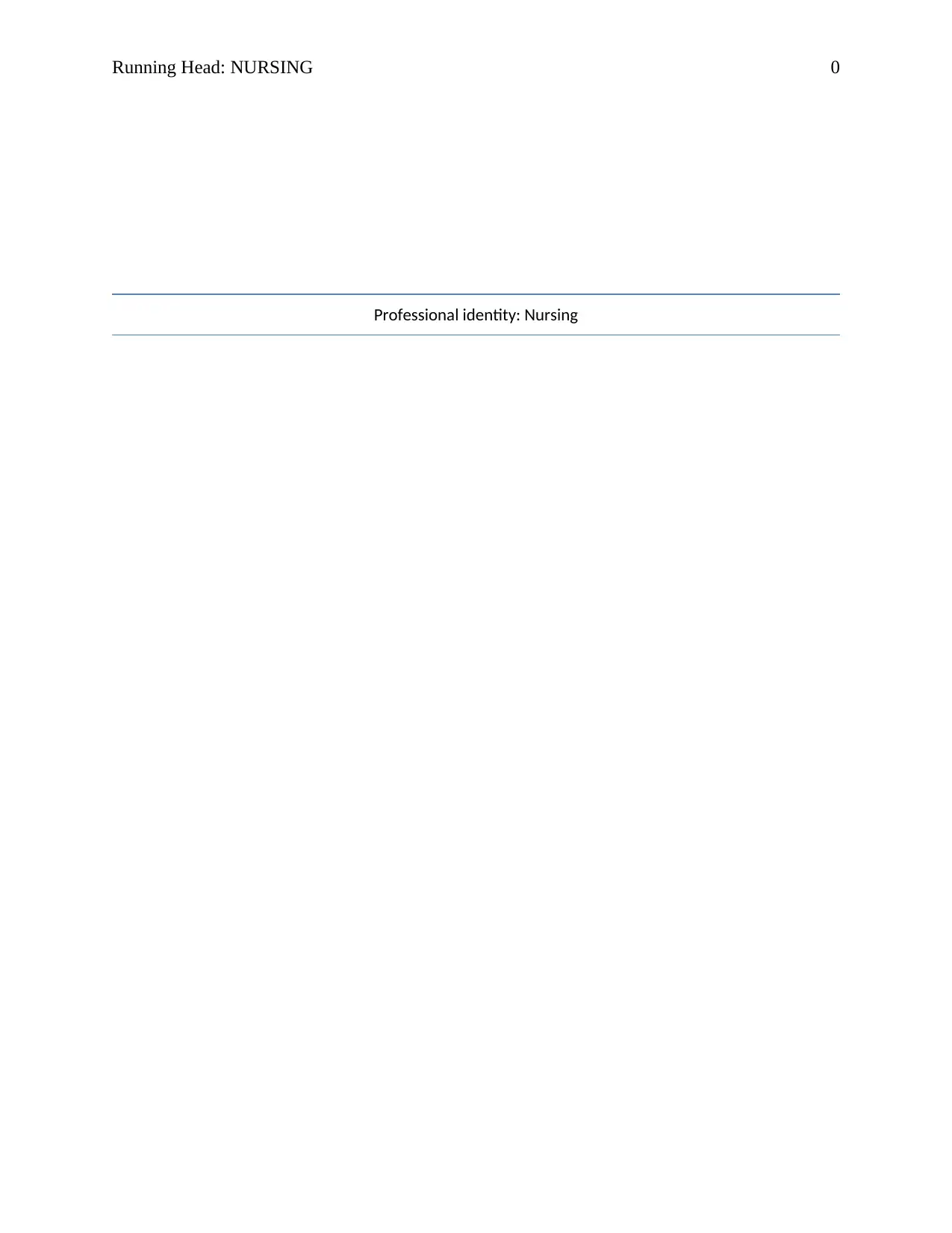
Running Head: NURSING 0
Professional identity: Nursing
Professional identity: Nursing
Paraphrase This Document
Need a fresh take? Get an instant paraphrase of this document with our AI Paraphraser
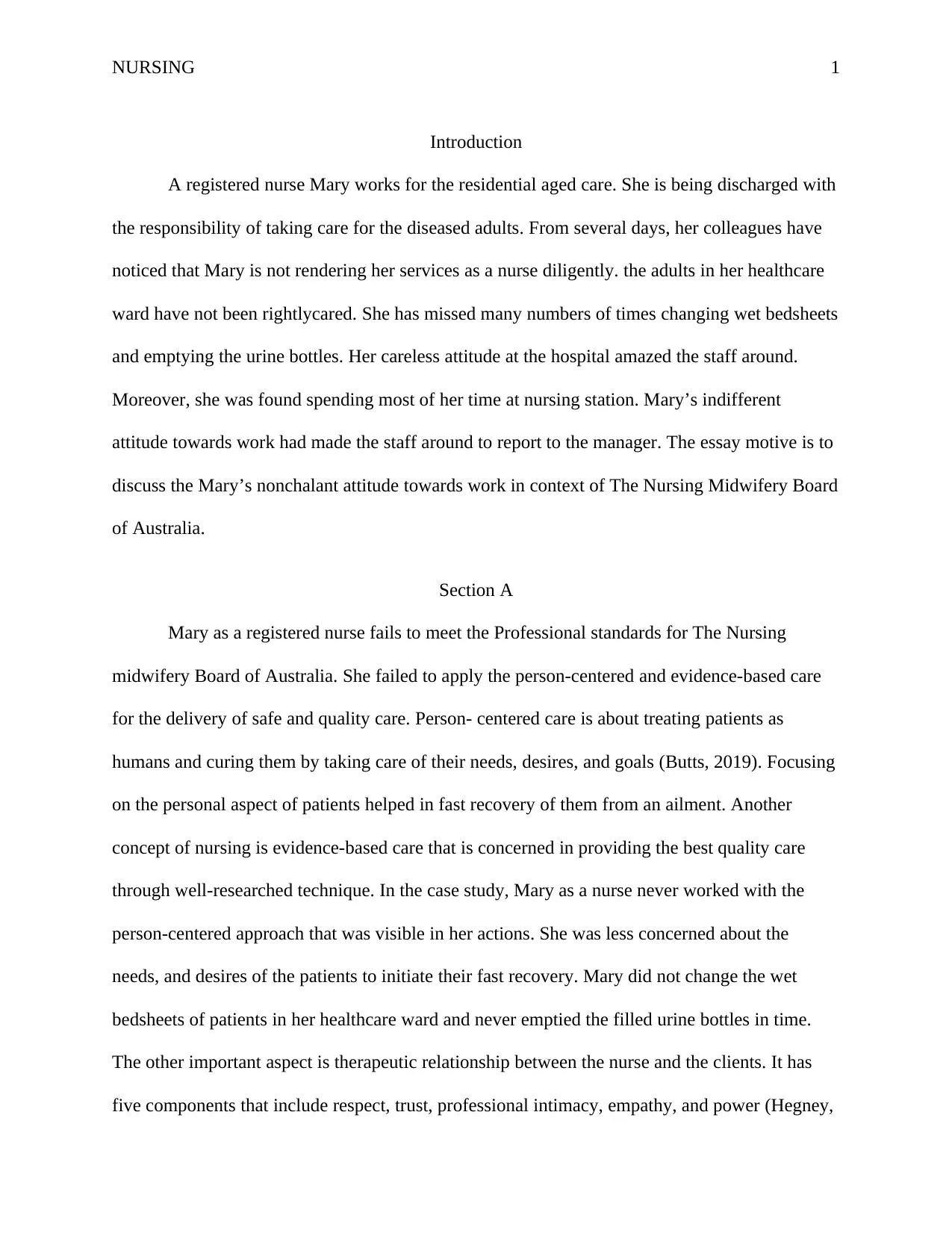
NURSING 1
Introduction
A registered nurse Mary works for the residential aged care. She is being discharged with
the responsibility of taking care for the diseased adults. From several days, her colleagues have
noticed that Mary is not rendering her services as a nurse diligently. the adults in her healthcare
ward have not been rightlycared. She has missed many numbers of times changing wet bedsheets
and emptying the urine bottles. Her careless attitude at the hospital amazed the staff around.
Moreover, she was found spending most of her time at nursing station. Mary’s indifferent
attitude towards work had made the staff around to report to the manager. The essay motive is to
discuss the Mary’s nonchalant attitude towards work in context of The Nursing Midwifery Board
of Australia.
Section A
Mary as a registered nurse fails to meet the Professional standards for The Nursing
midwifery Board of Australia. She failed to apply the person-centered and evidence-based care
for the delivery of safe and quality care. Person- centered care is about treating patients as
humans and curing them by taking care of their needs, desires, and goals (Butts, 2019). Focusing
on the personal aspect of patients helped in fast recovery of them from an ailment. Another
concept of nursing is evidence-based care that is concerned in providing the best quality care
through well-researched technique. In the case study, Mary as a nurse never worked with the
person-centered approach that was visible in her actions. She was less concerned about the
needs, and desires of the patients to initiate their fast recovery. Mary did not change the wet
bedsheets of patients in her healthcare ward and never emptied the filled urine bottles in time.
The other important aspect is therapeutic relationship between the nurse and the clients. It has
five components that include respect, trust, professional intimacy, empathy, and power (Hegney,
Introduction
A registered nurse Mary works for the residential aged care. She is being discharged with
the responsibility of taking care for the diseased adults. From several days, her colleagues have
noticed that Mary is not rendering her services as a nurse diligently. the adults in her healthcare
ward have not been rightlycared. She has missed many numbers of times changing wet bedsheets
and emptying the urine bottles. Her careless attitude at the hospital amazed the staff around.
Moreover, she was found spending most of her time at nursing station. Mary’s indifferent
attitude towards work had made the staff around to report to the manager. The essay motive is to
discuss the Mary’s nonchalant attitude towards work in context of The Nursing Midwifery Board
of Australia.
Section A
Mary as a registered nurse fails to meet the Professional standards for The Nursing
midwifery Board of Australia. She failed to apply the person-centered and evidence-based care
for the delivery of safe and quality care. Person- centered care is about treating patients as
humans and curing them by taking care of their needs, desires, and goals (Butts, 2019). Focusing
on the personal aspect of patients helped in fast recovery of them from an ailment. Another
concept of nursing is evidence-based care that is concerned in providing the best quality care
through well-researched technique. In the case study, Mary as a nurse never worked with the
person-centered approach that was visible in her actions. She was less concerned about the
needs, and desires of the patients to initiate their fast recovery. Mary did not change the wet
bedsheets of patients in her healthcare ward and never emptied the filled urine bottles in time.
The other important aspect is therapeutic relationship between the nurse and the clients. It has
five components that include respect, trust, professional intimacy, empathy, and power (Hegney,
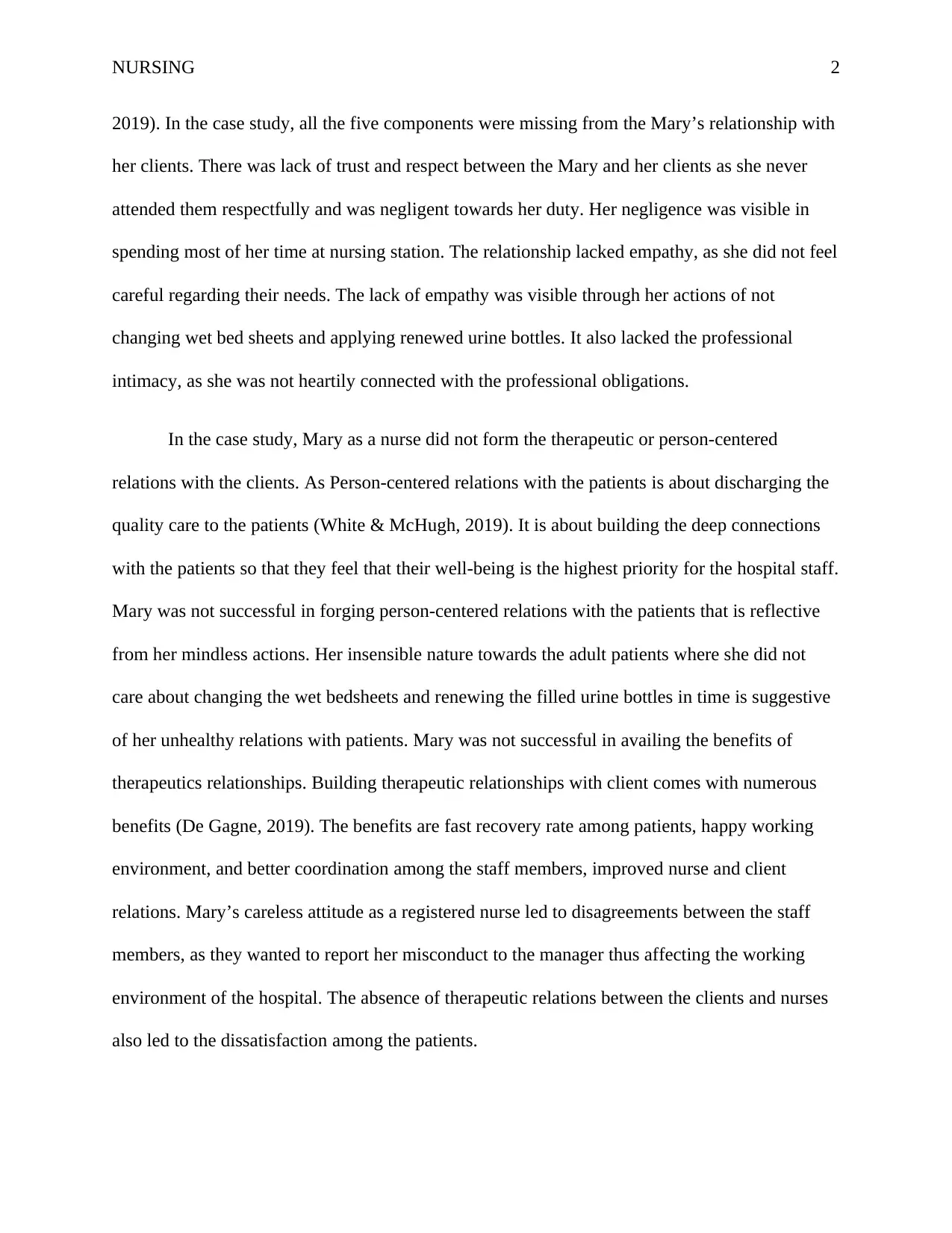
NURSING 2
2019). In the case study, all the five components were missing from the Mary’s relationship with
her clients. There was lack of trust and respect between the Mary and her clients as she never
attended them respectfully and was negligent towards her duty. Her negligence was visible in
spending most of her time at nursing station. The relationship lacked empathy, as she did not feel
careful regarding their needs. The lack of empathy was visible through her actions of not
changing wet bed sheets and applying renewed urine bottles. It also lacked the professional
intimacy, as she was not heartily connected with the professional obligations.
In the case study, Mary as a nurse did not form the therapeutic or person-centered
relations with the clients. As Person-centered relations with the patients is about discharging the
quality care to the patients (White & McHugh, 2019). It is about building the deep connections
with the patients so that they feel that their well-being is the highest priority for the hospital staff.
Mary was not successful in forging person-centered relations with the patients that is reflective
from her mindless actions. Her insensible nature towards the adult patients where she did not
care about changing the wet bedsheets and renewing the filled urine bottles in time is suggestive
of her unhealthy relations with patients. Mary was not successful in availing the benefits of
therapeutics relationships. Building therapeutic relationships with client comes with numerous
benefits (De Gagne, 2019). The benefits are fast recovery rate among patients, happy working
environment, and better coordination among the staff members, improved nurse and client
relations. Mary’s careless attitude as a registered nurse led to disagreements between the staff
members, as they wanted to report her misconduct to the manager thus affecting the working
environment of the hospital. The absence of therapeutic relations between the clients and nurses
also led to the dissatisfaction among the patients.
2019). In the case study, all the five components were missing from the Mary’s relationship with
her clients. There was lack of trust and respect between the Mary and her clients as she never
attended them respectfully and was negligent towards her duty. Her negligence was visible in
spending most of her time at nursing station. The relationship lacked empathy, as she did not feel
careful regarding their needs. The lack of empathy was visible through her actions of not
changing wet bed sheets and applying renewed urine bottles. It also lacked the professional
intimacy, as she was not heartily connected with the professional obligations.
In the case study, Mary as a nurse did not form the therapeutic or person-centered
relations with the clients. As Person-centered relations with the patients is about discharging the
quality care to the patients (White & McHugh, 2019). It is about building the deep connections
with the patients so that they feel that their well-being is the highest priority for the hospital staff.
Mary was not successful in forging person-centered relations with the patients that is reflective
from her mindless actions. Her insensible nature towards the adult patients where she did not
care about changing the wet bedsheets and renewing the filled urine bottles in time is suggestive
of her unhealthy relations with patients. Mary was not successful in availing the benefits of
therapeutics relationships. Building therapeutic relationships with client comes with numerous
benefits (De Gagne, 2019). The benefits are fast recovery rate among patients, happy working
environment, and better coordination among the staff members, improved nurse and client
relations. Mary’s careless attitude as a registered nurse led to disagreements between the staff
members, as they wanted to report her misconduct to the manager thus affecting the working
environment of the hospital. The absence of therapeutic relations between the clients and nurses
also led to the dissatisfaction among the patients.
⊘ This is a preview!⊘
Do you want full access?
Subscribe today to unlock all pages.

Trusted by 1+ million students worldwide
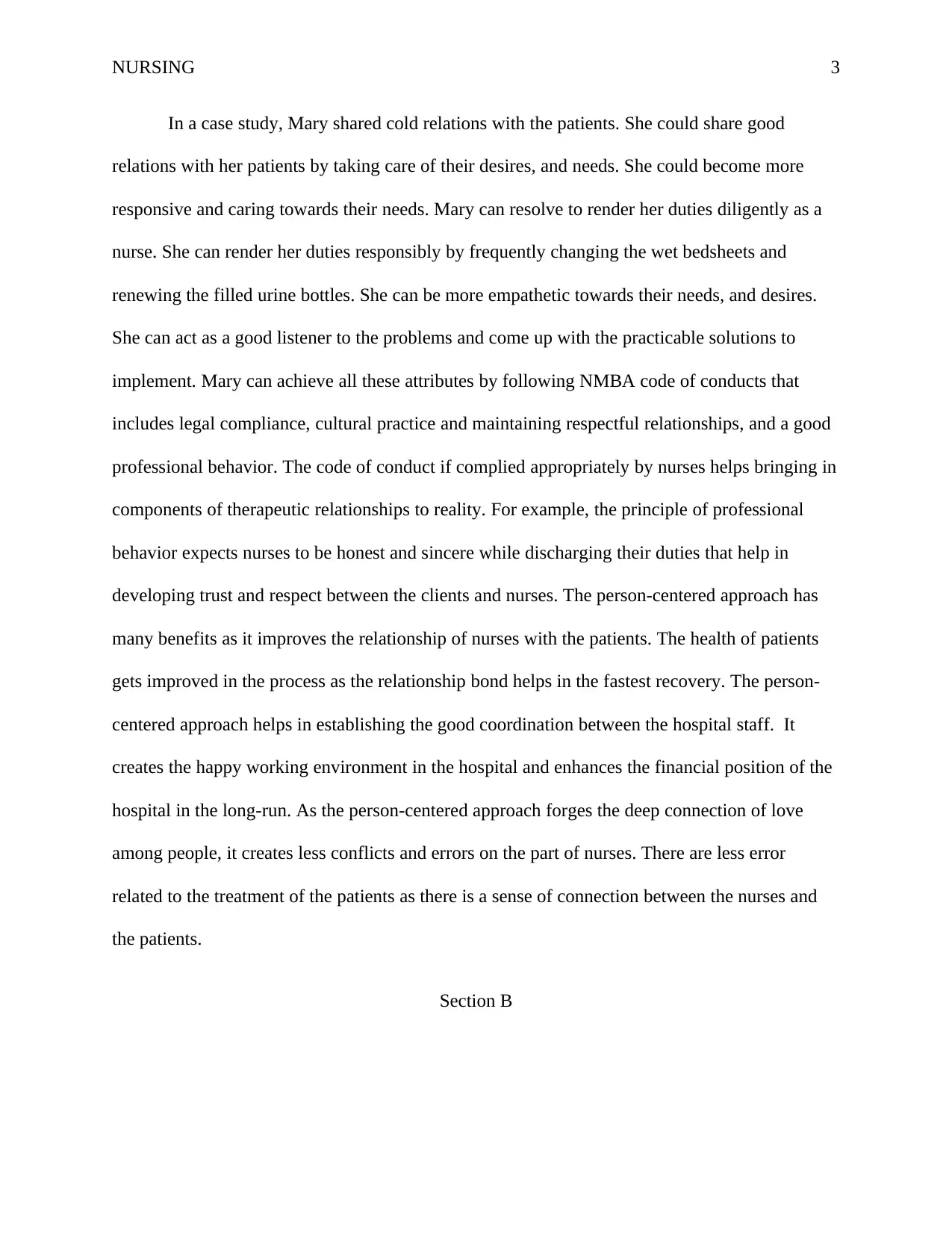
NURSING 3
In a case study, Mary shared cold relations with the patients. She could share good
relations with her patients by taking care of their desires, and needs. She could become more
responsive and caring towards their needs. Mary can resolve to render her duties diligently as a
nurse. She can render her duties responsibly by frequently changing the wet bedsheets and
renewing the filled urine bottles. She can be more empathetic towards their needs, and desires.
She can act as a good listener to the problems and come up with the practicable solutions to
implement. Mary can achieve all these attributes by following NMBA code of conducts that
includes legal compliance, cultural practice and maintaining respectful relationships, and a good
professional behavior. The code of conduct if complied appropriately by nurses helps bringing in
components of therapeutic relationships to reality. For example, the principle of professional
behavior expects nurses to be honest and sincere while discharging their duties that help in
developing trust and respect between the clients and nurses. The person-centered approach has
many benefits as it improves the relationship of nurses with the patients. The health of patients
gets improved in the process as the relationship bond helps in the fastest recovery. The person-
centered approach helps in establishing the good coordination between the hospital staff. It
creates the happy working environment in the hospital and enhances the financial position of the
hospital in the long-run. As the person-centered approach forges the deep connection of love
among people, it creates less conflicts and errors on the part of nurses. There are less error
related to the treatment of the patients as there is a sense of connection between the nurses and
the patients.
Section B
In a case study, Mary shared cold relations with the patients. She could share good
relations with her patients by taking care of their desires, and needs. She could become more
responsive and caring towards their needs. Mary can resolve to render her duties diligently as a
nurse. She can render her duties responsibly by frequently changing the wet bedsheets and
renewing the filled urine bottles. She can be more empathetic towards their needs, and desires.
She can act as a good listener to the problems and come up with the practicable solutions to
implement. Mary can achieve all these attributes by following NMBA code of conducts that
includes legal compliance, cultural practice and maintaining respectful relationships, and a good
professional behavior. The code of conduct if complied appropriately by nurses helps bringing in
components of therapeutic relationships to reality. For example, the principle of professional
behavior expects nurses to be honest and sincere while discharging their duties that help in
developing trust and respect between the clients and nurses. The person-centered approach has
many benefits as it improves the relationship of nurses with the patients. The health of patients
gets improved in the process as the relationship bond helps in the fastest recovery. The person-
centered approach helps in establishing the good coordination between the hospital staff. It
creates the happy working environment in the hospital and enhances the financial position of the
hospital in the long-run. As the person-centered approach forges the deep connection of love
among people, it creates less conflicts and errors on the part of nurses. There are less error
related to the treatment of the patients as there is a sense of connection between the nurses and
the patients.
Section B
Paraphrase This Document
Need a fresh take? Get an instant paraphrase of this document with our AI Paraphraser
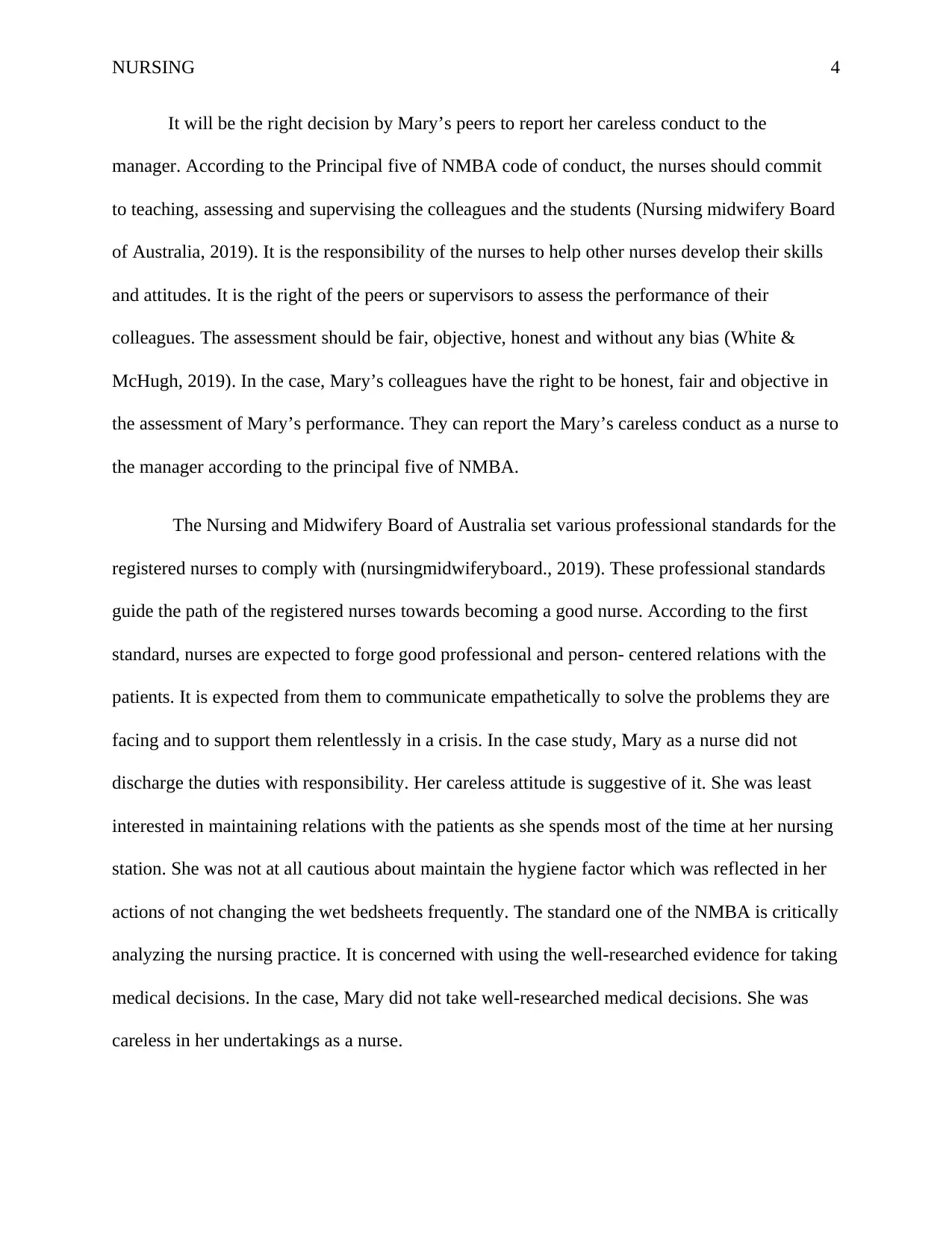
NURSING 4
It will be the right decision by Mary’s peers to report her careless conduct to the
manager. According to the Principal five of NMBA code of conduct, the nurses should commit
to teaching, assessing and supervising the colleagues and the students (Nursing midwifery Board
of Australia, 2019). It is the responsibility of the nurses to help other nurses develop their skills
and attitudes. It is the right of the peers or supervisors to assess the performance of their
colleagues. The assessment should be fair, objective, honest and without any bias (White &
McHugh, 2019). In the case, Mary’s colleagues have the right to be honest, fair and objective in
the assessment of Mary’s performance. They can report the Mary’s careless conduct as a nurse to
the manager according to the principal five of NMBA.
The Nursing and Midwifery Board of Australia set various professional standards for the
registered nurses to comply with (nursingmidwiferyboard., 2019). These professional standards
guide the path of the registered nurses towards becoming a good nurse. According to the first
standard, nurses are expected to forge good professional and person- centered relations with the
patients. It is expected from them to communicate empathetically to solve the problems they are
facing and to support them relentlessly in a crisis. In the case study, Mary as a nurse did not
discharge the duties with responsibility. Her careless attitude is suggestive of it. She was least
interested in maintaining relations with the patients as she spends most of the time at her nursing
station. She was not at all cautious about maintain the hygiene factor which was reflected in her
actions of not changing the wet bedsheets frequently. The standard one of the NMBA is critically
analyzing the nursing practice. It is concerned with using the well-researched evidence for taking
medical decisions. In the case, Mary did not take well-researched medical decisions. She was
careless in her undertakings as a nurse.
It will be the right decision by Mary’s peers to report her careless conduct to the
manager. According to the Principal five of NMBA code of conduct, the nurses should commit
to teaching, assessing and supervising the colleagues and the students (Nursing midwifery Board
of Australia, 2019). It is the responsibility of the nurses to help other nurses develop their skills
and attitudes. It is the right of the peers or supervisors to assess the performance of their
colleagues. The assessment should be fair, objective, honest and without any bias (White &
McHugh, 2019). In the case, Mary’s colleagues have the right to be honest, fair and objective in
the assessment of Mary’s performance. They can report the Mary’s careless conduct as a nurse to
the manager according to the principal five of NMBA.
The Nursing and Midwifery Board of Australia set various professional standards for the
registered nurses to comply with (nursingmidwiferyboard., 2019). These professional standards
guide the path of the registered nurses towards becoming a good nurse. According to the first
standard, nurses are expected to forge good professional and person- centered relations with the
patients. It is expected from them to communicate empathetically to solve the problems they are
facing and to support them relentlessly in a crisis. In the case study, Mary as a nurse did not
discharge the duties with responsibility. Her careless attitude is suggestive of it. She was least
interested in maintaining relations with the patients as she spends most of the time at her nursing
station. She was not at all cautious about maintain the hygiene factor which was reflected in her
actions of not changing the wet bedsheets frequently. The standard one of the NMBA is critically
analyzing the nursing practice. It is concerned with using the well-researched evidence for taking
medical decisions. In the case, Mary did not take well-researched medical decisions. She was
careless in her undertakings as a nurse.
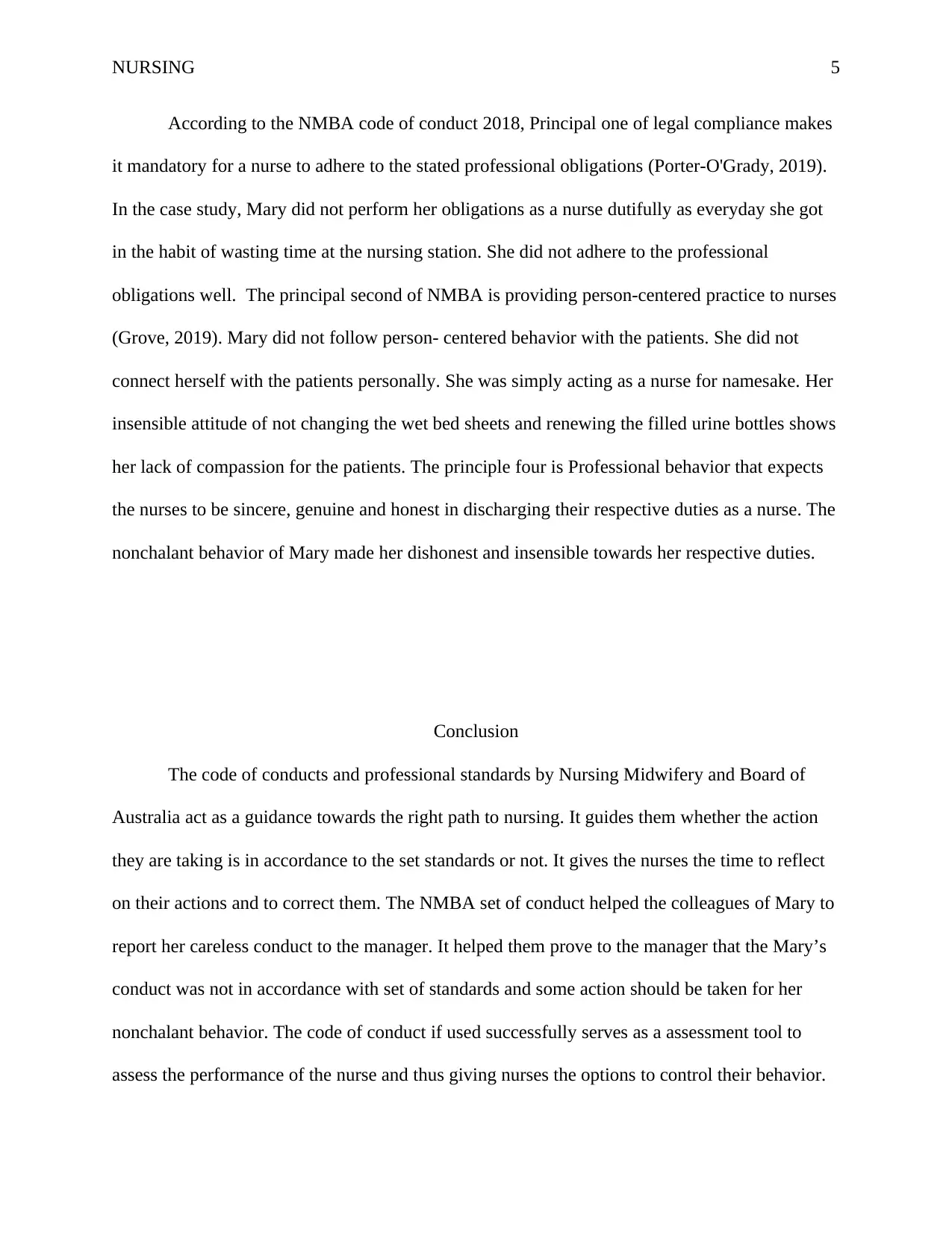
NURSING 5
According to the NMBA code of conduct 2018, Principal one of legal compliance makes
it mandatory for a nurse to adhere to the stated professional obligations (Porter-O'Grady, 2019).
In the case study, Mary did not perform her obligations as a nurse dutifully as everyday she got
in the habit of wasting time at the nursing station. She did not adhere to the professional
obligations well. The principal second of NMBA is providing person-centered practice to nurses
(Grove, 2019). Mary did not follow person- centered behavior with the patients. She did not
connect herself with the patients personally. She was simply acting as a nurse for namesake. Her
insensible attitude of not changing the wet bed sheets and renewing the filled urine bottles shows
her lack of compassion for the patients. The principle four is Professional behavior that expects
the nurses to be sincere, genuine and honest in discharging their respective duties as a nurse. The
nonchalant behavior of Mary made her dishonest and insensible towards her respective duties.
Conclusion
The code of conducts and professional standards by Nursing Midwifery and Board of
Australia act as a guidance towards the right path to nursing. It guides them whether the action
they are taking is in accordance to the set standards or not. It gives the nurses the time to reflect
on their actions and to correct them. The NMBA set of conduct helped the colleagues of Mary to
report her careless conduct to the manager. It helped them prove to the manager that the Mary’s
conduct was not in accordance with set of standards and some action should be taken for her
nonchalant behavior. The code of conduct if used successfully serves as a assessment tool to
assess the performance of the nurse and thus giving nurses the options to control their behavior.
According to the NMBA code of conduct 2018, Principal one of legal compliance makes
it mandatory for a nurse to adhere to the stated professional obligations (Porter-O'Grady, 2019).
In the case study, Mary did not perform her obligations as a nurse dutifully as everyday she got
in the habit of wasting time at the nursing station. She did not adhere to the professional
obligations well. The principal second of NMBA is providing person-centered practice to nurses
(Grove, 2019). Mary did not follow person- centered behavior with the patients. She did not
connect herself with the patients personally. She was simply acting as a nurse for namesake. Her
insensible attitude of not changing the wet bed sheets and renewing the filled urine bottles shows
her lack of compassion for the patients. The principle four is Professional behavior that expects
the nurses to be sincere, genuine and honest in discharging their respective duties as a nurse. The
nonchalant behavior of Mary made her dishonest and insensible towards her respective duties.
Conclusion
The code of conducts and professional standards by Nursing Midwifery and Board of
Australia act as a guidance towards the right path to nursing. It guides them whether the action
they are taking is in accordance to the set standards or not. It gives the nurses the time to reflect
on their actions and to correct them. The NMBA set of conduct helped the colleagues of Mary to
report her careless conduct to the manager. It helped them prove to the manager that the Mary’s
conduct was not in accordance with set of standards and some action should be taken for her
nonchalant behavior. The code of conduct if used successfully serves as a assessment tool to
assess the performance of the nurse and thus giving nurses the options to control their behavior.
⊘ This is a preview!⊘
Do you want full access?
Subscribe today to unlock all pages.

Trusted by 1+ million students worldwide
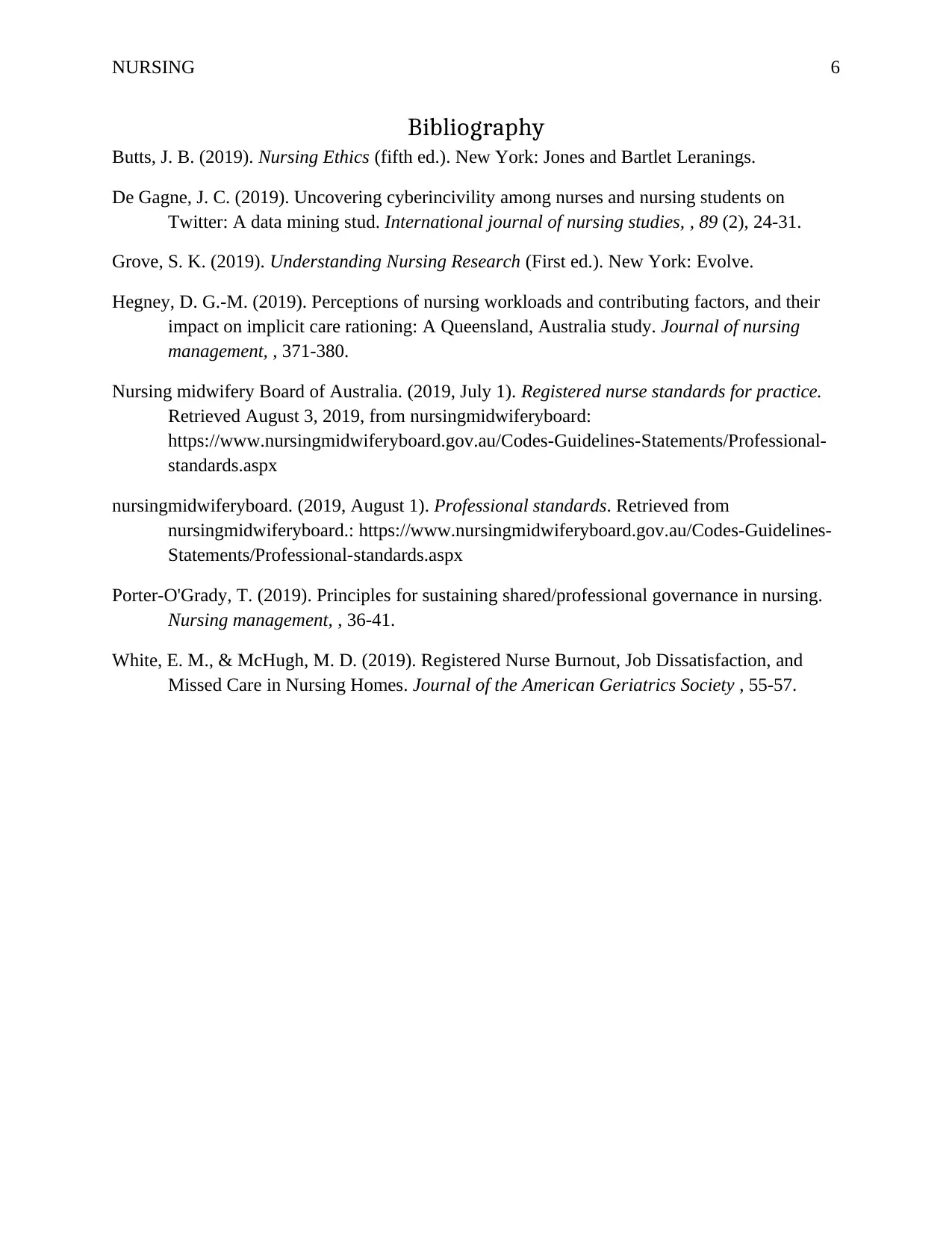
NURSING 6
Bibliography
Butts, J. B. (2019). Nursing Ethics (fifth ed.). New York: Jones and Bartlet Leranings.
De Gagne, J. C. (2019). Uncovering cyberincivility among nurses and nursing students on
Twitter: A data mining stud. International journal of nursing studies, , 89 (2), 24-31.
Grove, S. K. (2019). Understanding Nursing Research (First ed.). New York: Evolve.
Hegney, D. G.‐M. (2019). Perceptions of nursing workloads and contributing factors, and their
impact on implicit care rationing: A Queensland, Australia study. Journal of nursing
management, , 371-380.
Nursing midwifery Board of Australia. (2019, July 1). Registered nurse standards for practice.
Retrieved August 3, 2019, from nursingmidwiferyboard:
https://www.nursingmidwiferyboard.gov.au/Codes-Guidelines-Statements/Professional-
standards.aspx
nursingmidwiferyboard. (2019, August 1). Professional standards. Retrieved from
nursingmidwiferyboard.: https://www.nursingmidwiferyboard.gov.au/Codes-Guidelines-
Statements/Professional-standards.aspx
Porter-O'Grady, T. (2019). Principles for sustaining shared/professional governance in nursing.
Nursing management, , 36-41.
White, E. M., & McHugh, M. D. (2019). Registered Nurse Burnout, Job Dissatisfaction, and
Missed Care in Nursing Homes. Journal of the American Geriatrics Society , 55-57.
Bibliography
Butts, J. B. (2019). Nursing Ethics (fifth ed.). New York: Jones and Bartlet Leranings.
De Gagne, J. C. (2019). Uncovering cyberincivility among nurses and nursing students on
Twitter: A data mining stud. International journal of nursing studies, , 89 (2), 24-31.
Grove, S. K. (2019). Understanding Nursing Research (First ed.). New York: Evolve.
Hegney, D. G.‐M. (2019). Perceptions of nursing workloads and contributing factors, and their
impact on implicit care rationing: A Queensland, Australia study. Journal of nursing
management, , 371-380.
Nursing midwifery Board of Australia. (2019, July 1). Registered nurse standards for practice.
Retrieved August 3, 2019, from nursingmidwiferyboard:
https://www.nursingmidwiferyboard.gov.au/Codes-Guidelines-Statements/Professional-
standards.aspx
nursingmidwiferyboard. (2019, August 1). Professional standards. Retrieved from
nursingmidwiferyboard.: https://www.nursingmidwiferyboard.gov.au/Codes-Guidelines-
Statements/Professional-standards.aspx
Porter-O'Grady, T. (2019). Principles for sustaining shared/professional governance in nursing.
Nursing management, , 36-41.
White, E. M., & McHugh, M. D. (2019). Registered Nurse Burnout, Job Dissatisfaction, and
Missed Care in Nursing Homes. Journal of the American Geriatrics Society , 55-57.
1 out of 7
Related Documents
Your All-in-One AI-Powered Toolkit for Academic Success.
+13062052269
info@desklib.com
Available 24*7 on WhatsApp / Email
![[object Object]](/_next/static/media/star-bottom.7253800d.svg)
Unlock your academic potential
Copyright © 2020–2025 A2Z Services. All Rights Reserved. Developed and managed by ZUCOL.





